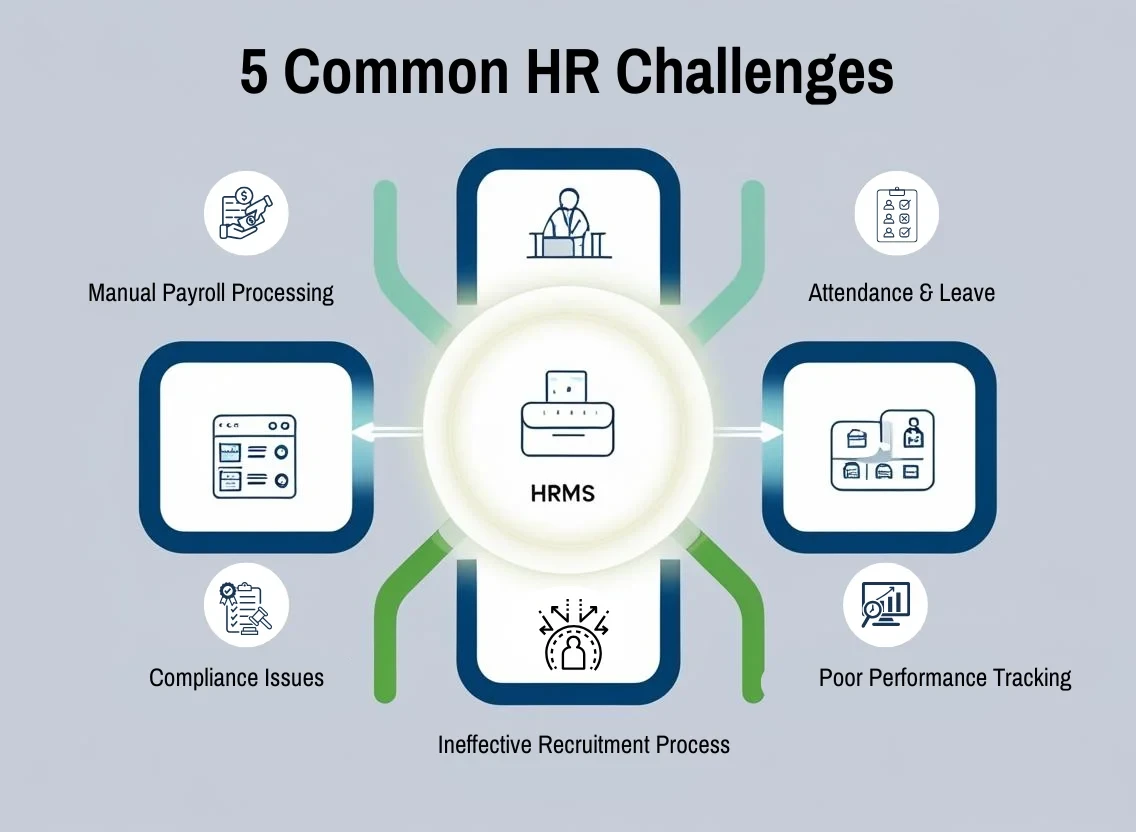
5 Common HR Challenges and How HRMS Can Solve Them
Today's corporate world moves too fast for HR to be bogged down in forms, files, and red tape from days of old. Rather than waiting months or years for a tangible result, executives with a 21st-century approach need actionable data and bottom-line results. Yet even with HR automation functionality, HR teams are still plagued by recurring issues that slow processes down, raise compliance red flags, and upset employer satisfaction. That is where a Human Resource Management System (HRMS) fits in, by allowing automation, accuracy, and reporting to help transform HR operations. In this blog, we’ll explore five common HR challenges and look at how a modern HRMS can solve them efficiently.
Five common HR challenges
1. Manual Payroll Processing
The Challenge: Manually processing payroll is a lengthy process and comes with the risk of errors. A small mistake can lead to salary disputes, compliance violations, and loss of trust by your employees. How HRMS Can Help: An HRMS system automates salary calculations, deductions, bonuses, tax compliance, and much more with a few clicks. Making sure that you can:
Accurately calculate all salaries.
Statutory compliance is automatic (PF, ESI, TDS, etc)
Salary can be disbursed on time.
Generation of payslips is simple.
2. Tracking Employee Attendance and Leave
The Challenge: Keeping manual records of attendance and leave applications leads to errors, disputes, and can be a challenge in calculating total work hours, overtime, or entitled leaves. How HRMS Helps: A cloud-based attendance and leave management system:
Track all attendance in real-time
Support check-ins from biometric devices or mobiles
Automates leave approval workflows
Maintains accurate leave balances
3. Poor Employee Engagement
The Challenge: Increased turnover, decreased productivity, and a poor organizational culture can come from under-performing employees who are less engaged. HR teams struggle with engagement- measuring it and improving it. How an HRMS can help: An HRMS provides enhanced performance management and feedback systems. Engagement features include:
Continuous performance management
Employee surveys and polls
Recognition and rewards programs
Data-driven analytics on engagement levels
4. Compliance and Data Security Risks
The Challenge: Assist in keeping businesses compliant with labor laws — that are changing, and more complex, faster than ever before—and ensure employee information is handled appropriately. Keeping records manually leads to non-compliance How HRMS Reduces Risks: Effective HRMS ensures
Provides automatic updates for statutory compliance.
Secure storage in the cloud with role-based access.
Audit trails and reporting functions.
GDPR compliance and successful local data protection compliance.
5. Ineffective Recruitment Process
The Problem: It is important to recruit the best talent quickly. Recruitment processes that are manual must be time-consuming and make it difficult to track applicants effectively. How HRMS can Help: HRMS has an integrated applicant tracking system (ATS) that is:
Job postings across multiple platforms
Real-time candidate tracking
Automated interview scheduling
Pipeline of talent for future recruitment
Final Thoughts
While it is true that HR teams have challenges but do not make them Roadblocks! There are multiple ways in which implementing a cloud-based HRMS solution can help your organization automate the mundane, correct mistaken entries, remain compliant, and keep employees engaged while saving money and time. So, if you have your HR team still in the trap of making notes on the spreadsheet and doing things manually, then it is probably the right time to learn how EasyHR's HRMS can help you with all these major functions.




